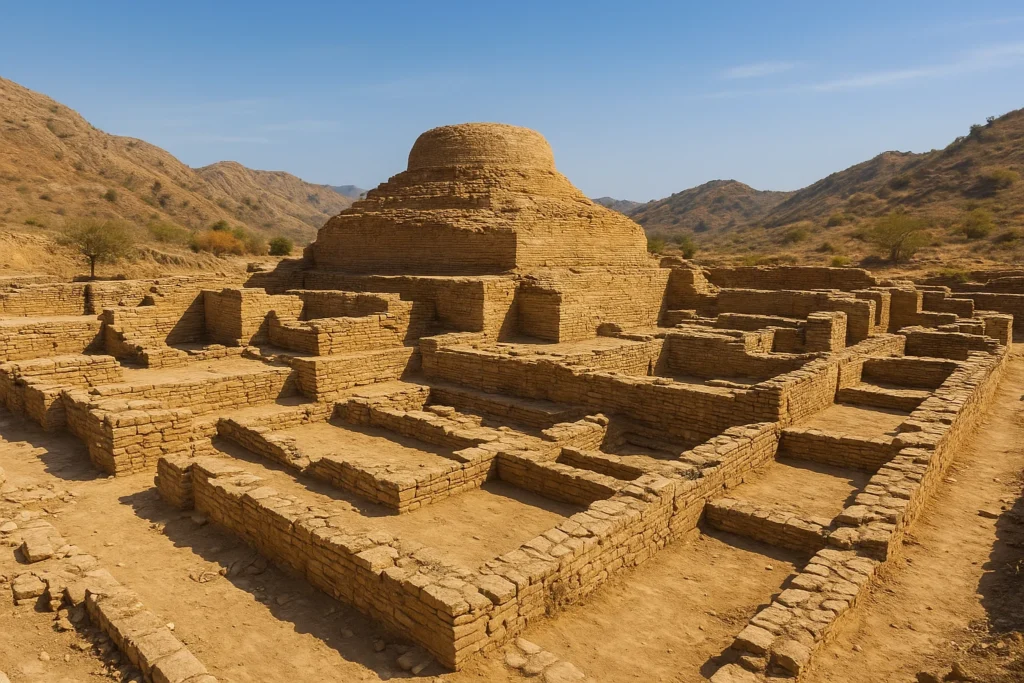Prologue: The Mountain’s Secret
The crisp morning air carried the scent of pine as local farmer Sher Ali guided the Italian archaeological team up the steep slopes near Barikot. His calloused hands brushed aside wildflowers to reveal what had brought them here – strange, weathered stones protruding from the earth like broken teeth. “We’ve known about these for generations,” Ali murmured, “but no one ever dug deeper.”
Dr. Luca Maria Olivieri adjusted his glasses, his experienced eyes immediately recognizing the telltale signs of ancient masonry. As the first trowels bit into the soil that day in 2022, none of them suspected they were about to uncover one of the most complete early Buddhist monasteries ever found in the region – a perfectly preserved time capsule from Gandhara’s golden age.
Chapter 1: The Monastery That Time Forgot
The Grand Revelation
After three excavation seasons, the full scale of the discovery became clear. The team had uncovered:
- A 2.5-acre monastic complex dating from the 1st century BCE to 5th century CE
- Four distinct construction phases showing architectural evolution
- 37 monk cells arranged in concentric circles around the main stupa
- A refectory hall with evidence of communal dining
- Three subsidiary stupas marking important burial sites
Architectural Marvels
The main stupa stood as the complex’s crown jewel. Rising nearly 15 meters in its prime, its base featured:
- Greek-style engaged columns alternating with Buddhist motifs
- Narrative friezes depicting Jataka tales (Buddha’s previous lives)
- A unique double-dome construction unseen in other Gandharan sites
Nearby, the vihara (monks’ quarters) revealed astonishing details of daily life:
- Plaster walls with faint traces of original paint
- Stone platforms that served as beds
- Niche walls for oil lamps and small Buddha statues
- Ventilation shafts demonstrating advanced engineering
Chapter 2: Treasures from the Earth
The Artifact Collection
The soil yielded over 2,300 catalogued objects, including:
Religious Artifacts:
- A schist stone reliquary containing bone fragments wrapped in gold foil
- 72 votive tablets with molded Buddha images
- A bronze ritual bell with Sanskrit inscriptions
Daily Life Objects:
- Glass perfume bottles from Roman Egypt
- Ivory cosmetic tools likely from India
- Bronze surgical instruments matching those described in ancient medical texts
Numismatic Evidence:
- Indo-Greek coins of King Menander I
- Kushan-era gold coins of Kanishka the Great
- Roman denarii from Emperor Tiberius’ reign
The Scriptorium Discovery
One chamber contained:
- Carbonized palm-leaf manuscripts (being digitally reconstructed)
- Ink pots with dried pigments still present
- A scribe’s toolkit including styluses and a miniature whetstone
This may represent the oldest confirmed Buddhist scriptorium in the region.
Chapter 3: Gandhara – The Cradle of Buddhist Civilization
Historical Context
The Gandhara civilization flourished from:
- 6th century BCE (Achaemenid period)
- Peak 1st-5th centuries CE (Kushan Empire)
- Decline after 7th century (White Hun invasions)
Cultural Synthesis
This region uniquely blended:
- Hellenistic Influences:
- Alexander’s successors established Greek cities
- Artistic techniques like chiaroscuro shading
- Corinthian columns in religious architecture
- Indian Traditions:
- Buddhist philosophy and iconography
- Ayurvedic medical knowledge
- Sanskrit literary traditions
- Central Asian Elements:
- Nomadic Kushan rulers
- Zoroastrian motifs in early art
- Silk Road trade networks
The Buddhist Renaissance
Key developments originating in Gandhara:
- First anthropomorphic Buddha images (previously represented symbolically)
- Mahayana Buddhism’s formative period
- Translation movement of Sanskrit texts to Chinese
Chapter 4: Daily Life in the Monastery
A Monk’s Routine
Based on archaeological evidence and Vinaya texts:
Morning (4:30 AM):
- Bell rings for meditation
- Sutra recitation in assembly hall
- Alms round in nearby villages
Midday:
- Single vegetarian meal
- Debate and study sessions
- Manuscript copying duties
Evening:
- Personal meditation
- Chanting ceremonies
- Early retirement to cells
Economic Foundations
The monastery sustained itself through:
- Royal Patronage:
- Land grants from Kushan kings
- Tax exemptions on trade goods
- Craft Production:
- Sculpture workshops
- Medical herb cultivation
- Manuscript reproduction
- Pilgrimage Economy:
- Lodging for travelers
- Ritual object sales
- Guided teaching sessions
Chapter 5: The Art of Gandhara
Sculptural Masterpieces
The site yielded exceptional examples of:
Standing Buddha Statues:
- Hellenistic drapery folds
- Distinctive “archaic smile”
- Halo with grapevine motifs
Narrative Reliefs:
- Birth of Siddhartha
- Great Departure scene
- First Sermon at Sarnath
Deity Images:
- Hariti (child-protector goddess)
- Panchika (wealth deity)
- Vajrapani (thunderbolt holder)
Painting Techniques
Wall fragments revealed:
- Fresco secco method
- Mineral pigments (lapis lazuli blue, cinnabar red)
- Gold leaf accents
- Perspective experiments
Chapter 6: The Monastery’s Final Days
Signs of Sudden Abandonment
Evidence suggests the site was hastily vacated:
- Unfinished sculptures in workshops
- Hidden caches of valuables never retrieved
- Sealed chambers with intact ritual objects
Possible Causes
- White Hun Invasions (5th century):
- Historical records describe monastery burnings
- Coins of Hunnic ruler Mihirakula found in destruction layers
- Climate Change:
- Pollen analysis shows drought patterns
- Changing trade routes reduced patronage
- Religious Shifts:
- Rising Hinduism in the region
- Decline of Silk Road Buddhism
Chapter 7: Modern Rediscovery
Excavation Challenges
The team faced:
- Unstable hillsides requiring terracing
- Groundwater seepage in lower chambers
- Delicate conservation of painted stucco
Technological Innovations
Cutting-edge methods employed:
- LIDAR scanning to map underground structures
- 3D photogrammetry of fragile artifacts
- Isotope analysis of metal objects
Chapter 8: Preserving the Legacy
Conservation Initiatives
Current projects include:
- Climate-controlled shelter over main stupa
- Digital reconstruction of mural paintings
- Local craftsman training in restoration techniques
Museum Development
The new Swat Archaeological Center will feature:
- Virtual reality tours of the original complex
- Interactive displays of monastic life
- Hands-on replica objects for visitors
Epilogue: Echoes Across Time
As twilight settles over the Swat Valley, the monastery’s stones seem to whisper stories of the countless pilgrims, monks, and artisans who once walked these paths. This remarkable discovery doesn’t just illuminate the past – it offers profound lessons about cultural exchange, spiritual perseverance, and humanity’s shared heritage.
The excavation continues, with each season revealing new wonders. Perhaps the greatest revelation is how much remains to be discovered about this crossroads of civilizations that shaped Buddhist art and thought across Asia.
Visiting the Site
Practical Information:
- Location: 12km northeast of Barikot, Swat Valley
- Best Season: April-October
- Guided Tours: Available through Peshawar Museum
- Nearby Attractions: Butkara Stupa, Saidu Sharif Museum
Preservation Guidelines:
- No touching of original surfaces
- Photography without flash only
- All finds must be reported to site staff
As you stand where ancient monks once meditated, surrounded by the same mountain vistas they contemplated, history ceases to be abstract dates in textbooks. It becomes a living connection across two millennia – a testament to the enduring human quest for meaning that transcends time and culture.




you are truly a just right webmaster The site loading speed is incredible It kind of feels that youre doing any distinctive trick In addition The contents are masterwork you have done a great activity in this matter
Your blog is a breath of fresh air in the often stagnant world of online content. Your thoughtful analysis and insightful commentary never fail to leave a lasting impression. Thank you for sharing your wisdom with us.